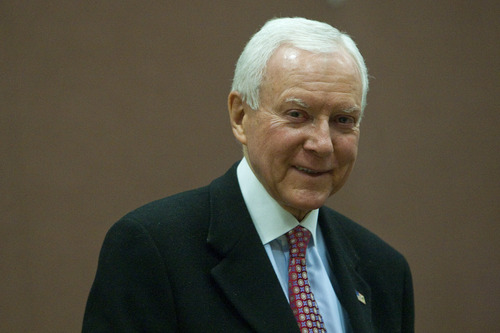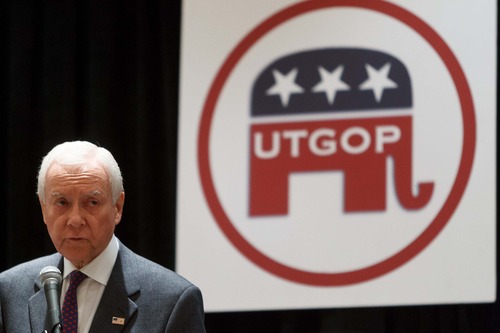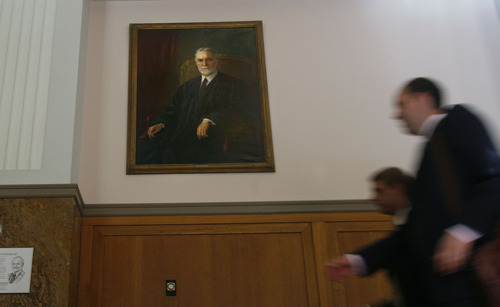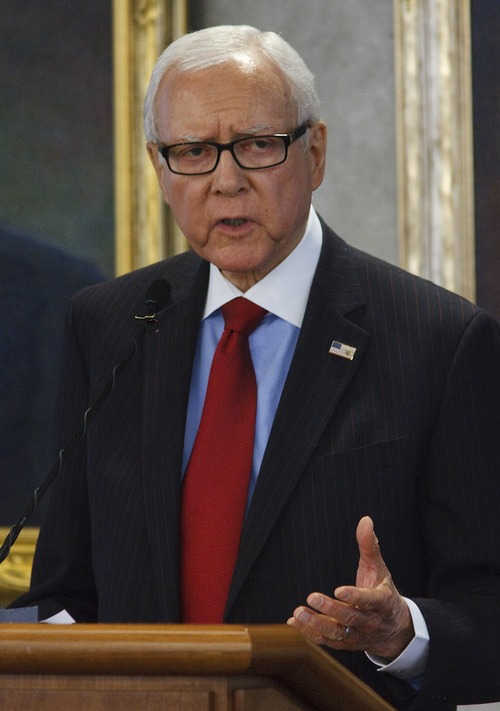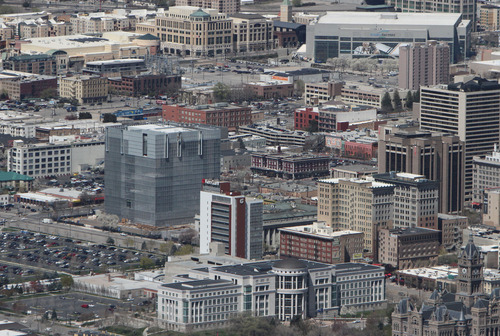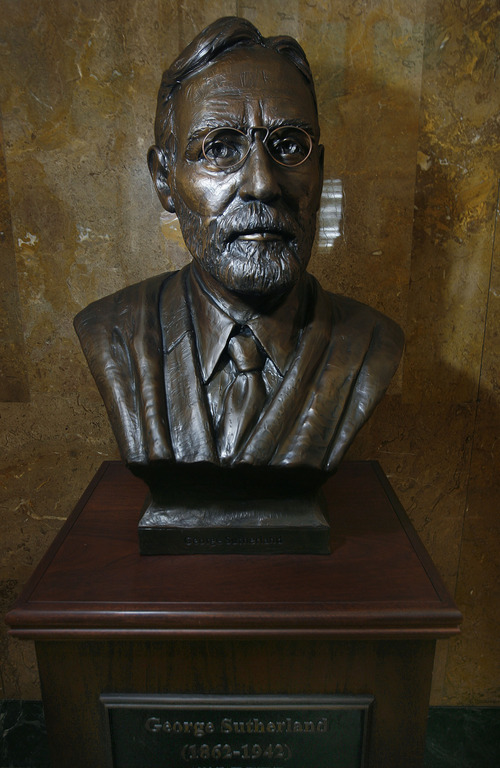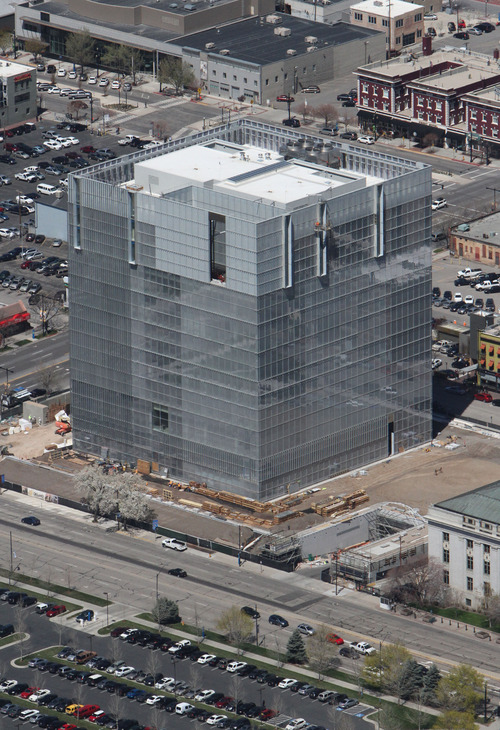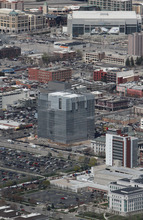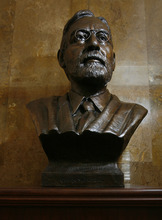This is an archived article that was published on sltrib.com in 2013, and information in the article may be outdated. It is provided only for personal research purposes and may not be reprinted.
Washington • It's a glass box of constitutional justicein downtown Salt Lake City, and one day it will be named after a prominent Utahn. The question is, who?
Two camps have quietly tussled over the honor even as construction crews continue to work on the new federal courthouse, slated to open in March. On one side is an aggressive litigator hoping to honor a legendary and long-deceased founder of his law firm, and on the other side are friends of Sen. Orrin Hatch. It really isn't a fair fight.
"My sense is that no one wants to get in the way of Senator Hatch if he wants his name on that building," said Andrew Morse, president of Snow, Christensen & Martineau.
Morse has prodded members of Congress and their advisers and sent letters to the Senate Judiciary Committee, but he has struggled to find anyone willing to sponsor a bill to name the structure after George Sutherland, the only Utahn to ever serve on the U.S. Supreme Court.
Hands off • For his part, Hatch calls the maneuvering "embarrassing" and says he doesn't want to be involved in any legislation to name the building.
"I've kind of kept my hands off of it because some have said they want it to be named after me," he told The Salt Lake Tribune recently. "I think it's none of my business."
He said talk of naming the courthouse after him is a "very kind gesture" but not one he has sought.
"I've never asked to have my name on anything. Period."
While some have talked about naming the building after former U.S.Solicitor General Rex E. Lee (the late father of Sen. Mike Lee) or former Sen. Bob Bennett, most people in Utah's political circles assumed the building would eventually be named after Hatch.
At 37 years and counting, he is not only Utah's longest-serving member of Congress, he has also held a seat on the Judiciary Committeelonger than anyone in history. That slot has allowed him to play a key role in naming every sitting judge on Utah's federal District Court. That includes Chief District Judge Ted Stewart, whose brother Chris Stewart is now the congressman who represents the downtown area where the behemoth new building rises.
Rep. Stewart, R-Utah, said he hasn't had lengthy conversations with his brother on the topic but is aware of how the judges view the senator.
"A lot of the federal judges feel like they owe their positions to Orrin Hatch," Chris Stewart said. "He went to bat for those guys."
With this in mind, the new congressman was preparing a bill to name the building after Hatch — then the rules got in the way.
Nameless • Congress forbids naming any federal building after a sitting lawmaker. If the new courthouse is going to be named after Hatch, it will have to wait until he retires, which he plans to do when his term ends in January 2019.
"The reality is there is nothing we can do," said Chris Stewart, who has shelved any plans for legislation about the courthouse.
Morse sees the rules as his opening, giving him time to persuade Congress to look past their colleague and give due consideration to a political legend from the turn of the century.
"You can't let the building go nameless for five years. That's like letting your kid go to first grade before giving him a name," Morse argues before sarcastically suggesting the building should be named "from a list of Utahns who have been on the Supreme Court."
Morse doesn't want people to attribute his aggressive support for Sutherland as a slight of Hatch, whom he calls "a great senator." Rather, his interest stems from research he conducted in 2011 while planning an event honoring his law firm's 125th anniversary. He organized a ceremony, which included Judge Stewart, focused on the firm's most famous alumni.
One of the 'Four Horsemen' • As a young boy, Sutherland emigrated from England to Utah, where he eventually graduated from what was then called Brigham Young Academy in 1881 and moved to Michigan to earn his law degree. He returned to Utah and was elected to the new state Legislature in 1896. He served one term in what was then Utah's only U.S. House seat beginning in 1901, then spent a dozen years in the U.S. Senate.
He left The Church of Jesus Christ of Latter-day Saints and became a Presbyterian, a move that played a role in his re-election defeat.
President Warren G. Harding nominated Sutherland to the U.S. Supreme Court in 1922, and the Senate confirmed him unanimously the same day. He was one of the famous "Four Horsemen," conservative justices who clashed with President Franklin D. Roosevelt's New Deal programs.
Sutherland stepped down from the bench in 1938 and died four years later.
His bust now sits in the existing federal court's foyer, a gift from Snow, Christensen & Martineau after its 2011 celebration of his life, where Judge Stewart was one of the dignitaries who honored Sutherland, joking he was speaking because Hatch had a scheduling conflict.
After the event, Morse and his politically active adviser, Sylvia Haro, asked friendly state lawmakers to push a resolution requesting that Utah's congressional delegation help name the courthouse after Sutherland.
It passed unanimously this year, and neither sponsor — state Rep. Johnny Anderson, R-Tayorsville, nor state Sen. Lyle Hillyard, R-Logan — ever heard from anyone associated with Hatch.
"I would have suspected if Senator Hatch was interested in it, he would have contacted people and said, 'Not so fast.' But I didn't hear anything," said Hillyard, an attorney and the longest-serving state senator.
But that doesn't mean Hatch supporters didn't take action.
Back-to-back• Around the same time the Legislature was voting on the resolution, the nine district judges led by Ted Stewart voted in a private meeting to name the largest courtroom in the new building after Sutherland. They also decided to put the bust from Snow, Christensen & Martineau at its front door — a strong hint they think the building should be named after someone else.
Morse said he appreciates the honor but doesn't think it goes far enough. After the Legislature passed the resolution, he began setting up meetings with each of Utah's four House members and two senators.
Like Chris Stewart, Republican Sen. Mike Lee supports naming the building after Hatch. "It is difficult to think of anyone who has served in the Senate who has had a greater impact on the federal judiciary than Orrin Hatch," said Lee.
Rep. Jim Matheson, D-Utah, is also open to that. Rep. Jason Chaffetz, R-Utah, plans to defer to colleagues as the building isn't in his congressional district. That leaves Rep. Rob Bishop, R-Utah, a former state House speaker who gives serious weight to the recommendations of the Legislature. He met with Morse in April and is considering whether to run a bill.
"I haven't decided yet," said Bishop. "Sutherland is worthy, other people are worthy."
But Bishop puzzled over the tussle.
"It is the ugliest building in Salt Lake City. Why would anyone want their name attached to that thing?"
After two decades of planning and scraping for federal funding, dignitaries, including Hatch, broke ground on the new courthouse in early 2011. The glass cube has 10 floors but appears far taller because of some extraordinarily high ceilings.
It sits next to the 108-year-old classical granite courthouse named in 1990 for Sen. Frank Moss, a three-term Democrat, whom Hatch defeated in 1976. The Moss Building will become the federalbankruptcy court in March.
The idea that the shiny new courthouse would be named for his father's nemesis is something Brian Moss accepts even if he doesn't particularly like it.
"I guess it seems a little bit awkward to some that they would be back-to-back there," he said. "On the other hand, they both gave long service to the U.S. Senate."
Twitter: @mattcanham


